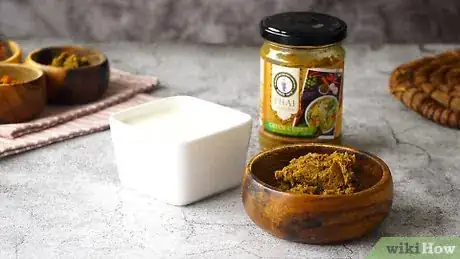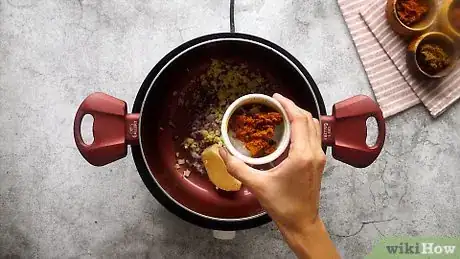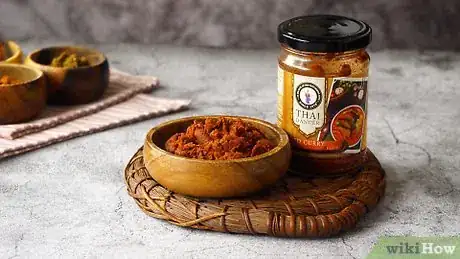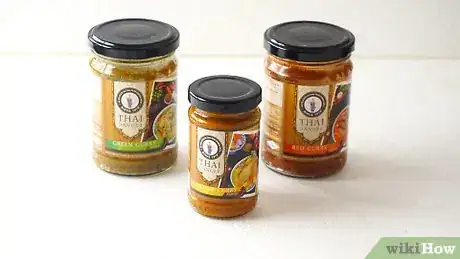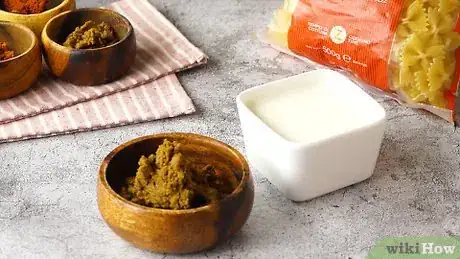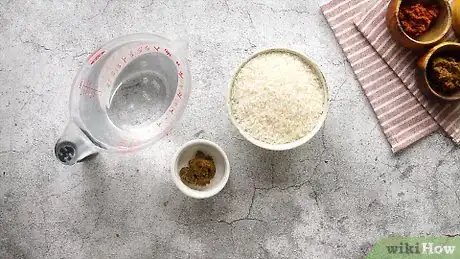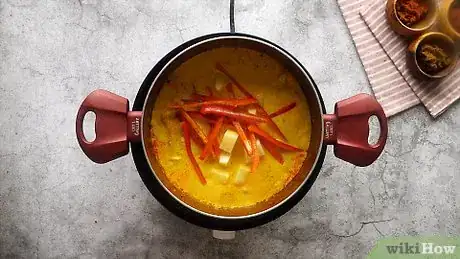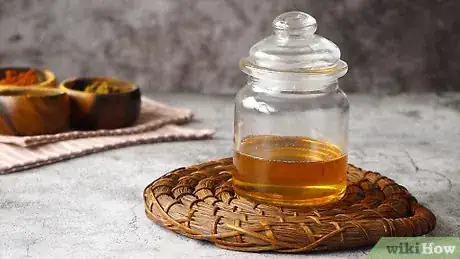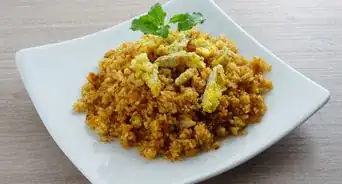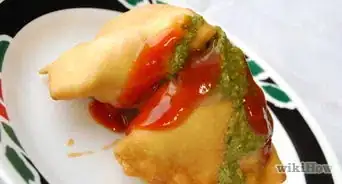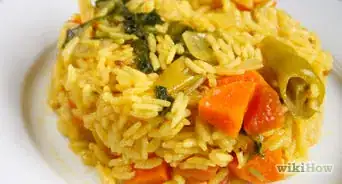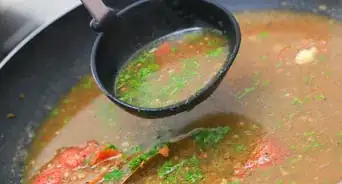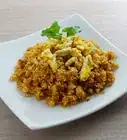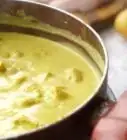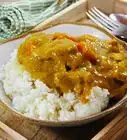This article was co-authored by Ed Kuoha. Ed Kuoha is a Chef and the Owner of Kuoha Culinary based in Aiea, Hawaii. He has more than 20 years of experience in various culinary kitchens and settings such as Morimoto Waikiki, where he received hands-on training from Iron Chef Morimoto. Chef Ed specializes in small catering events and private chef requests. He holds an Associate’s degree from The Culinary Institute of the Pacific at Kapiolani Community College.
There are 11 references cited in this article, which can be found at the bottom of the page.
This article has been viewed 50,687 times.
Curry paste, typically of Thai origin, is a versatile ingredient that can add a ton of flavor to your cooking. The main varieties are spicy green, mild yellow, and hot red pastes, which you can use in meat dishes, soups, curries, and vegetables. You can also blend them with condiments to add extra flavor to your favorite foods.
Steps
Learning the Basics of Curry Paste
-
1Mix green curry paste with coconut milk to tamper its spiciness. This paste is usually the hottest of the 3 pastes, which is why adding coconut milk is a good idea, as it dulls the spiciness. It typically contains kaffir lime leaves, shrimp paste, lemongrass, garlic, and green chilies. Try 1-2 teaspoons (17-34 g) for a can of coconut milk.[1]
- This works well for meat marinades as well as for making Thai green curry.
-
2Use yellow curry paste for a more mild, sweet flavor. This paste typically has cinnamon, cumin, lemongrass, garlic, and galangal in it, giving it a sweet and savory kick. Add a couple of spoonfuls to Thai-style soups for an instant boost of flavor.[2]
- Galangal has a similar flavor to ginger.
- This works well in soups.
Advertisement -
3Add red curry paste for a medium-hot flavor profile. This curry paste lends itself to a wider variety of uses, though it is spicy. It has red chilies, lemongrass, shallots, garlic, shrimp paste, galangal, and coriander roots and leaves. Add it to soups, condiments, sauces, and curries.[3]
- Coriander leaves are known as cilantro in the United States.
- Try this in a variety of dishes.
-
4Cook the paste in oil for 1-2 minutes before adding other ingredients. Add 1 to 2 tablespoons (15 to 30 mL) of olive oil to a pan on medium and let it heat up. Spoon in the amount of curry paste you want to use, and stir it around for a few minutes, which will help release the paste's flavors. Then, you can add other ingredients you plan on using.[4]
- If you're using onions or garlic, you can add the paste after these get translucent in the pan.
-
5Store curry paste in the refrigerator for 6 months. Curry paste is made to be kept for a long time. The oil in the paste will keep the ingredients fresh and potent, but only if you keep it in the refrigerator once you've opened it.[5]
- To keep it even fresher, try wiping the inside of the jar clean at the top. Then, pour in just enough olive oil to cover the top of the paste, which will form a barrier to help keep it fresher.
Pairing Curry Paste with Meats
-
1Mix curry paste in equal parts with olive oil to make a marinade. Use a whisk to mix the 2 ingredients together or pop them in the blender. Place chicken, pork, beef, or lamb in a bag or bowl. Pour the mixture over it, and stir or massage to combine the ingredients. Let it sit in the refrigerator for at least an hour.[6]
- Once the meat has marinated, shake off the extra sauce and cook it in a skillet, in the oven, or on the grill.
-
2Spoon curry paste over fish, shrimp, or poultry before roasting it. For a quick dinner with lots of flavor, use curry paste as a quick topping for your protein. Spread the curry paste evenly over your preferred protein, and then cook it as long as you normally would in the oven.[7]
- If you're afraid it will be a little too spicy, mix it with an equal portion of olive oil first.
- If your chicken has skin, rub the paste under it to help the skin brown better and keep the paste from burning.[8]
-
3Poach fish in a curry paste sauce. Add 1 tablespoon (15 mL) of olive oil to a pan. Slice up 3-4 small shallots and a piece of ginger 2 inches (5.1 cm) long. Add them to the pan with 2 minced garlic cloves and 2 teaspoons (34 grams) of curry paste. Let those cook for 5 minutes, then stir in 2 14 fl oz (410 mL) cans of coconut milk and 0.5 cups (120 mL) of white wine or chicken broth, as well as salt to taste. Let it come to a boil, then lay 4 cod fillets in the pan. Cover the pan and cook the fish 7-9 minutes, until it flakes easily.[9]
- You can also add 3 tablespoons (44 mL) of lime juice and 0.75 tablespoons (11.1 mL) of fish sauce if you have them.
- Near the end of cooking, you can add in finely sliced bok choy, cabbage, spinach, or kale and let it cook until it wilts.
- Substitute chicken or pork for the fish, but let the meat cook until there's no pink in the center.
Using Curry Paste with Veggies and Side Dishes
-
1Add 2 parts coconut milk or broth to 1 part curry paste for a pasta sauce. Keep adding milk or broth until it's thin enough to toss with noodles. Pour it over hot noodles and mix it together to create a tasty pasta dish.[10]
- Adjust the spiciness as needed by adding more or less paste.
-
2Mix green curry paste into the water while you're making rice. Add 1 tablespoon (50 grams) of green curry paste to 1 cup of rice (180 grams) and 2 cups (470 mL) of water. Add salt to taste and 1 to 2 tablespoons (15 to 30 mL) of olive oil or melted butter. Cook the rice as you normally would on the stove or in the rice cooker, and serve it as a side.[11]
- You can also layer chicken on top of the raw rice and water mixture and cook the whole thing in the oven until the rice is done and the chicken has no pink in the center, typically 30-40 minutes at 350 °F (177 °C).
-
3Make a quick vegetable curry with coconut milk. Saute your favorite vegetables in a pan, such as onions, cauliflower, sweet potato, and carrots. Let them partially cook, then add in enough coconut milk to submerge the veggies halfway. Stir in 1-2 tablespoons (50-100 grams) of curry paste to taste, and let it simmer until the vegetables are cooked through.[12]
- This is great over rice.
- Add chicken, shrimp, or chickpeas to this dish for protein.
- You can also add the curry paste with the onions to cook it a bit first.
Creating Tasty Condiments and Sauces
-
1Add curry paste to mayonnaise for a spicy mayo. For a spicy curry mayonnaise, mix 1 tablespoon (50 grams) of curry paste into 1 cup (230 grams) of mayonnaise and then taste the mixture. If it's too spicy, add a bit more mayonnaise. If it doesn't have enough flavor, add a bit more curry paste.[13]
- Use this mayonnaise on turkey or ham sandwiches for a zesty change to your normal routine. This is also good on fish tacos.
-
2Mix ketchup and curry paste for a fun and spicy fry dip. Stir 1 tablespoon (50 grams) of curry paste into 1 cup (230 grams) of ketchup before tasting it. Adjust the ketchup to your taste and desired spiciness by adding more curry paste or mayonnaise.[14]
- Try this on top of hot dogs or with fish sticks.
-
3Combine olive oil, vinegar, and curry paste for a salad dressing. Add 3 parts olive oil to 1 part curry paste and 1 part vinegar to a canning jar. Shake the ingredients together thoroughly. Pour the dressing over greens and add chopped veggies and a protein to the top for a tasty salad. You can use white wine, plain white, or apple cider vinegar.[15]
- For a creamy dressing, add 3 parts mayonnaise, sour cream, or yogurt to 2 parts olive oil and 1 part curry paste and vinegar or lemon juice. Mix them together thoroughly. Add a pinch of sugar if it needs sweetness.
- You can also use this as a dip.
-
4Create a dessert syrup with yellow curry paste. Make a simple syrup by heating 1 cup (240 mL) water and 1 cup (198 grams) of white granulated sugar on the stove until all the sugar has dissolved. Mix in the juice from half a lime and 1 tablespoon (50 g) of mild yellow curry paste until it's dissolved. Let it simmer for 5 minutes, then let it cool off the burner.[16]
- Top ice cream or rice pudding with the sauce.
- Store this syrup in the refrigerator for up to a month.
References
- ↑ https://www.foodnetwork.com/fn-dish/recipes/2011/07/red-curry-paste
- ↑ https://www.foodnetwork.com/fn-dish/recipes/2011/07/red-curry-paste
- ↑ https://www.foodnetwork.com/fn-dish/recipes/2011/07/red-curry-paste
- ↑ https://www.myrecipes.com/ingredients/are-curry-powder-and-curry-paste-interchangeable
- ↑ https://www.myrecipes.com/ingredients/are-curry-powder-and-curry-paste-interchangeable
- ↑ https://www.foodnetwork.com/fn-dish/recipes/2011/07/red-curry-paste
- ↑ https://www.thekitchn.com/5-ways-to-use-thai-curry-paste-223576
- ↑ https://www.cookinglight.com/cooking-101/essential-ingredients/ways-to-use-red-curry-paste
- ↑ https://www.cookinglight.com/recipes/thai-poached-cod
- ↑ https://www.thekitchn.com/5-ways-to-use-thai-curry-paste-223576
- ↑ https://www.seriouseats.com/2014/10/what-to-do-with-thai-curry-paste.html
- ↑ https://www.foodnetwork.com/fn-dish/recipes/2011/07/red-curry-paste
- ↑ https://www.foodnetwork.com/fn-dish/recipes/2011/07/red-curry-paste
- ↑ https://www.foodnetwork.com/fn-dish/recipes/2011/07/red-curry-paste
- ↑ https://www.thekitchn.com/5-ways-to-use-thai-curry-paste-223576
- ↑ https://www.seriouseats.com/2014/10/what-to-do-with-thai-curry-paste.html
About This Article
To use curry paste, choose the type of curry that fits the level of spice you want. For example, green curry is very spicy, while yellow curry is more sweet and mild, and red curry is somewhere in between. Whichever curry paste you choose, cook it for 1-2 minutes with 1-2 tablespoons (15-30 mL) of olive oil to help release the flavor of the curry before adding it to a dish. To tone down the flavor of spicier curries, such as green curry, combine the curry with a bit of coconut milk to taste. Once you’ve cooked the curry, mix equal parts curry paste and olive oil to make a marinade. Or, simply coat a piece of meat with the paste before cooking it if you don’t want to wait for it to marinate. You can also mix curry paste into soups, sauces, or even the water you use for cooking rice.
